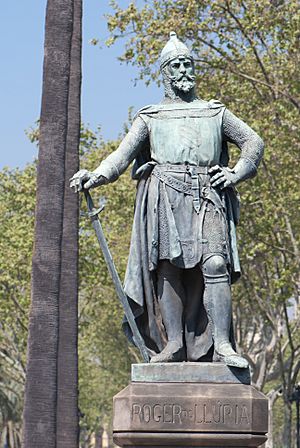Roger of Lauria facts for kids
Quick facts for kids
Ruggero di Lauria i d'Amichi
|
|
|---|---|

Statue of Roger of Lauria in Barcelona
|
|
| Born | 1245 Lauria or Scalea, Kingdom of Sicily |
| Died | 19 January 1305 Valencia, Kingdom of Valencia |
| Allegiance | Kingdom of Sicily |
| Years of service | 1283–1302 |
| Rank | Admiral |
| Battles/wars | War of the Sicilian Vespers |
Roger of Lauria (around 1245 – January 19, 1305) was a very skilled admiral from Italy. He served the Crown of Aragon and led their fleet during the War of the Sicilian Vespers. Many people believe he was one of the most successful naval leaders of the Middle Ages. He is also known as Ruggero or Ruggiero di Lauria in Italian, and Roger de Llúria in Catalan.
Contents
Roger of Lauria: A Master of the Seas
Roger of Lauria was a famous admiral who lived a long time ago. He was known for being incredibly smart and brave in sea battles. He helped the Kingdom of Aragon become very powerful on the seas.
Early Life and Rise to Power
Roger was born in southern Italy, either in Lauria or Scalea, around 1245. His father, Richard of Lauria, was an important judge in the Kingdom of Sicily. His mother, Donna Bella, was a nurse to Constance of Sicily, who later became a queen.
After a king named Conradin was executed in 1268, Roger and his mother had to leave their home. They found safety in Barcelona, which was part of the Crown of Aragon.
Later, King Peter III of Aragon married Constance of Sicily. He made Roger a knight. In 1282, King Peter chose Roger to lead the entire Aragonese fleet. Roger kept this important job under Peter's sons, James II and Frederick III.
Roger of Lauria led the Aragonese fleet when they tried to take Sicily from the Angevins. This happened after a big revolt in 1282 called the Sicilian Vespers. Roger fought and won six major sea battles.
The Battle of Malta (1283)
On July 8, 1283, Roger defeated the Angevins in the Grand Harbour during the Battle of Malta. This was a big win for the Aragonese.
The Battle of Castellammare (1284)
Less than a year later, on June 5, 1284, he defeated the Neapolitan fleet. This battle took place at Castellammare. Roger even captured the enemy leader, Charles of Salerno, who later became King Charles II of Naples.
The Battle of Les Formigues (1285)
On September 4, 1285, Roger won another important battle. This time, he defeated the French fleet near Barcelona during the Aragonese Crusade. This victory greatly weakened French naval power in the Mediterranean Sea for a long time. Soon after, he also helped in a land battle called the Battle of the Col de Panissars.
The Battle of the Counts (1287)
On June 23, 1287, Roger again defeated the Angevins near Naples in the Battle of the Counts. Even though his fleet had only forty ships and the enemy had eighty, he still won! After this victory, he made a peace agreement with the Neapolitans.
Later Years and More Battles
When Frederick III became King of Sicily, Roger was rewarded with land and a castle near Aci Castello. But Roger and the young King Frederick soon had problems. Roger even joined the Angevins for a short time. Frederick then attacked Roger's castle, and Roger was captured. However, he managed to escape and left Sicily. All his lands were taken away.
Roger then worked for Edward I of England to fight against the French. But he soon returned to Italy. On July 4, 1299, he defeated the Sicilians near Sicily in the Battle of Cape Orlando. He captured eighteen enemy ships.
He had another great victory on June 14, 1300, at the Battle of Ponza. In this battle, he defeated and even captured King Frederick himself! After a peace treaty called the Peace of Caltabellotta, Roger made up with Frederick and was forgiven. He then retired to Cocentaina in the Kingdom of Valencia, where he passed away in 1305.
Roger's Clever Battle Tactics
Roger was so successful in naval warfare because he used very smart tactics.
- Luring the Enemy: He would often pretend to retreat to trick enemy fleets into chasing him. This would make the enemy ships disorganized. Then, Roger would suddenly turn his ships into a strong formation and attack.
- Controlling His Fleet: He had much better control over his ship captains than his enemies did. His fleet worked together like a well-oiled machine.
- Specialized Crews: His crews were made up of specialized fighters. His archers and crossbowmen would shoot first. His oarsmen and Almogavars (tough, unarmored soldiers armed with spears and daggers) would stay hidden until the ships got close.
- Close Combat: When his ships got close, they would often hit the sides of enemy ships, damaging their oars. His agile skirmishers were much better at fighting on a moving ship deck than the heavily armored knights his enemies often used.
- Trickery: Roger sometimes used tricks to hide how many ships he had. He would also keep some of his ships hidden to attack the enemy from behind once the battle started.
Roger was also known for being very tough and determined. His strong reputation alone sometimes made his enemies lose courage during a battle.
Namesakes
Several ships and military units have been named after Roger of Lauria to honor him:
- The Regia Marina (Royal Navy) battleship Ruggiero di Lauria, completed in 1888, was named for him.
- Roger de Lauria was a destroyer in the Spanish Navy, launched in 1967.
- One of the main paratrooper units of the Spanish airborne forces is named after him.
See also
 In Spanish: Roger de Lauria para niños
In Spanish: Roger de Lauria para niños

